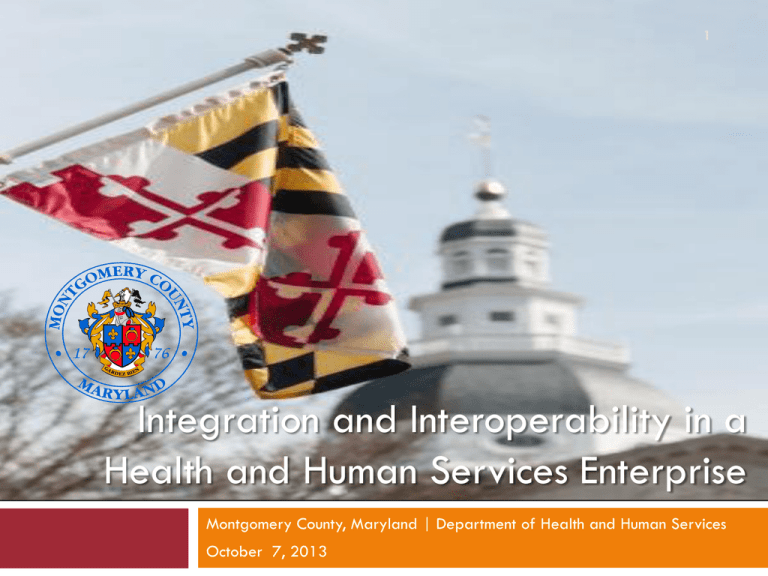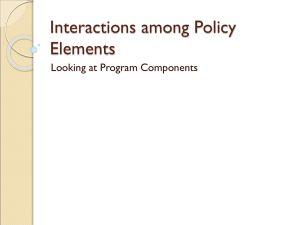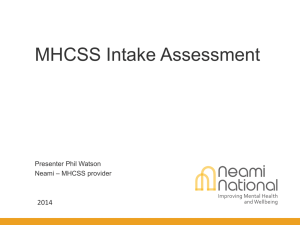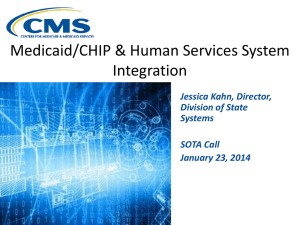ISM-2013-Interoperability-Uma-Ahluwalia
advertisement

1 Integration and Interoperability in a Health and Human Services Enterprise Montgomery County, Maryland | Department of Health and Human Services October 7, 2013 WHO WE ARE: Information about our County Almost 1 Million Residents __________ 31% Foreign Born 50.6% Ethnic Minority 17% Growth in our senior population over the next 2years 49,344 out of 148,779 children in the public school system receive FARMS 6 Zip Codes of Extreme Need — Poverty on the Rise Served 120,000 Households in Fiscal Year 2012. One-third used more than two services from Department A Staff of 1,600 with over 80 Programs Caseloads Growing TCA: 43.4% SNAP: 166% MA: 68.7% Serving almost 36,000 uninsured adults, children and pregnant women 3 Department of Health and Human Services 3 How is the Department Organized? 4 In 1994, Four Departments Became One Entity OBJECTIVE: Integrated, Coordinated and Comprehensive Service Delivery Montgomery County Department and Health and Human Services Continuum of Programs Aging and Disability Services Behavioral Health and Crisis Services Children, Youth and Family Services John J. Kenney Chief Raymond Crowel Chief Mental Health Services Adults and Seniors Children and Adolescents Multicultural Mental Health Services Core Service Agency Substance Abuse | Addiction Services Crisis Stabilization Juvenile Justice Partner Abuse Victim Abuse Boards and commissions .. Alcohol and Other Drug Abuse Advisory Committee .. Mental Health Advisory Committee Information and Assessment Services Home and Community Support Services Community Support Network | Disability Services Home Care Adult Protective Services | Case Management Services Nutrition Program Assisted Living and Skilled Nursing Facilities Assisted Living Services Ombudsman Program Boards and Commissions .. Commission on Aging .. Commission on People with Disabilities .. Adult Public Guardianship Review Board 5 Public Health Services Special Needs Housing Office of Community Affairs Kate Garvey Chief and Social Services Officer Ulder J. Tillman Chief and Health Officer Nadim Khan Chief Betty Lam Chief Linkages to Learning Child Welfare Child and Adolescent Services Early Childhood Services Gang Prevention Initiative Income Supports and Child Care Subsidy Liaison Work with MCPS Boards and Commissions .. Commission on Children and Youth .. Commission on Child Care .. Commission on Juvenile Justice .. Citizens Review Panel Community Health Services Communicable Disease| BioTerrorism Cancer and Tobacco Initiatives Licensure and Regulatory Services Assisted Living Facilities Certification School Health Montgomery Cares Health Promotion Health Partnerships and Planning Long Term Care Medical Assistance and Outreach Special Projects Boards and Commissions .. Commission on Health .. Montgomery Cares Advisory Board Housing Stabilization | Emergency Services to Prevent Homelessness Economic Supports Emergency Assistance Grants Welfare Avoidance Grants 60-Month Intervention Resource Supports Preventive Crisis Intervention with Case Management Rental and Home Energy Assistance Program RAP - Shallow Rental Subsidy Program SHRAP – Deep Rental Subsidy Program Handicapped Rental Assistance Program Home Energy Assistance Program Homeless Continuum of Care Coordination (Supported through non-profit partners) Single Adult Shelters w|case management Motel Placements and Overflow Shelters Transitional Programs Permanent Supportive Housing Community Action Agency Community Outreach Disparity Reduction Diversity Initiatives and the three Minority Health Initiatives LEP Compliance How is DHHS Organized? 6 Moving towards single client record supported by an interoperable database One Director Centralized Administrative Functions Uniform intake form to identify all service needs Designated entire HHS entity as HIPAA covered – including social service and income support programs No Wrong Door in the Future. 7 Seamless customer experience integrated in all 50 sites (27 program sites and 23 clinic sites) Key to the experience will be: Access to all DHHS Programs Shared information and data Customer telling their story once TECHNOLOGY MODERNIZATION An Aspect of Interoperability. 9 Technology Modernization Integrated Case Practices Integrated Business Process Enterprise-wide Client View Improved Outcomes Analytics and Individual Client Focus and Population Health Focus The Process and Technology Modernization (PTM) Program lays the foundation for changing DHHS service delivery over the next few years. 10 Drivers Changes in service delivery best practice Changes required by the Affordable Care Act (ACA) implementation Difficulty/cost in maintaining many one-off applications supporting programs Inefficiencies from using multiple state systems Goals Improve client outcomes Reduce overall costs of treatment Establish single platform for most service delivery Prepare for ACA-mandated changes Simplify ongoing application maintenance Realize vision of integrated DHHS Service Delivery Today. 11 The PTM Program will help HHS transform from disjointed, inefficient, program-based silos … Clients have to Service Integration “shop” for services Treatment Treatment Treatment Treatment Treatment Assessment Assessment Assessment Assessment Assessment Eligibility Eligibility Eligibility Eligibility Eligibility Intake Intake Intake Intake Intake Aging & Disability Behavioral Children Youth & Families Public Health Special Needs Housing Health No consolidated view of client engagement with HHS Integrated service delivery for only the hardest-toserve clients Service Delivery Tomorrow. 12 … to a more integrated service delivery model that treats clients holistically and cost-effectively. Treatment No Wrong Door for residents needing services Assessment Eligibility Intake Aging & Disability Behavioral Health Client Children Youth & Families Public Health Special Needs Housing Consolidated view of client engagement across most programs Integrated service delivery where appropriate We adopted four guiding principles to serve as touchstones as we move forward. Because we want to provide seamless, consistent services to our clients across HHS, we seek to define and implement common processing, approaches and methods throughout HHS 13 Because we want to maintain and upgrade our systems over time, we will leverage the existing functionality of the software as fully as possible and minimize customization Because we want to treat clients in holistic, integrated manner, we will share information about our clients and their treatment within HHS, unless prohibited by law We will never let the perfect be the enemy of the good The PTM Program includes 7 Interrelated Projects. 14 IT Implementations 1. 2. 3. Enterprise Integrated Case Management (EICM) Enterprise Content Management System (ECMS) Electronic Health Record (EHR) Supporting Projects 4. 5. 6. 7. US HHS Interoperability Grant Organizational Change Management (OCM) Project Management Office (PMO) Quality Assurance (QA) Target Phase 3 First Half A B Application HUB (share application; eliminate dual entry) Appointment Eligibility Check-in / Registration Application Dependencies Determination Scheduling Clearance Integrations/Conversions (single view of client) Dependencies – CIS/SAIL integration – Person Query (existing), Person Registration, Case Query (existing) Case Registration (CARES, OHEP), ECMS Data conversion - CIS, CARES, OHEP Subsumed Appointment Scheduling Application Eligibility Determination Program Referral Case Assignment WPA ADS Risk Assessment RAP Service Area Customization 15 Service Area / Local Program Specific D C Registration LotC Common/Core Functions C Check-in / Clearance Target Phase 3 Second Half A Application HUB (Add new sources) B Integrations/Conversions (Add new sources) Service Plan Provider / Serice Match Provider Enrollment Service Referrals (Manual) Case Dispensation WPA ADS Risk Assessment RAP Service Area Customization Reporting/Analytics 16 Service Area / Local Program Specific D C Service Strategy LotC Common/Core Functions C Record Assessment Results Conversion and Batch Integration Strategy State/Federal Systems of Record Iterative Conversion Process Integration with Systems of Record 18 NIEM – Based Application Hub 19 eICM Case Management Modules CASE MANAGEMENT Automated in eICM SERVICE TRANSACTION Current process Using System of Record MANAGE CASE ACTIVITY DELIVER UNITS OF SERVICE MANAGE CLIENT PARTICIPATION VERIFY CLIENT PARTICIPATION MONITOR CLIENT PROGRESS REPORT SERVICE MILESTONES MONITOR PROVIDER FULFILLMENT MANAGE SERVICE BUDGET INVOICE FOR SERVICES RENDERED 20 CM/ST Interactions 21 eICM Service Referral Provider Batch Process Service Transaction Details Case Manager State System of Record Service Transaction Details CONFIDENTIALITY AND PRIVACY An Aspect of Interoperability. 23 Sharing of Information Policy and Practice Business Process Need to Know Role-Based Access Balance between Interoperability/Data-sharing and Guarding against Breaches Confidentiality: 24 Sharing Information within our MultiService Agency Definition of treatment in the regulations include “related services” In context of our department, related services include income support and social services Addressing a client’s basic food or shelter needs greatly impacts the effectiveness of health care Both the intent of the law and language in the rulemaking process supports this broad interpretation Revised Notice of Privacy Practices Common Resources Training Authorization Form Infrastructure to Promote Service Integration and Ensure Privacy Compliance Minimum Necessary 25 Role-based Access; Access based on a job related purpose Department- Wide Policy (Example: Safeguarding Policy) Why Integrate Data? 26 Over 30% of our clients use multiple services Clients often have to tell their story multiple times and data has to be entered multiple times. Increases the risk of errors in the re-telling and re-entering Without a master client index, it is hard to tell what services a client is getting across our enterprise and often services are duplicated and there is waste and inefficiency Makes re-use of data impossible and it makes it more difficult for clients to access multiple services across the enterprise What is our Approach? 27 We have a HIPAA Policy and Risk Manager leading an office of 2.5 positions Continuously updating and staying on top of the federal and state policy environment Continuously training and working to align policy Our Process and Technology Modernization efforts which include the following – ECMS, eICMS, EHR, MCI, Legacy Systems and MCDHHS Portal will have policy, business process and practice alignment for HIPAA, 42CFR and other privacy statutes and regulations RETURN ON (TAXPAYER) INVESTMENT/SOCIAL RETURN ON INVESTMENT Work led by JHU Public Health Informatics School and Accenture Slides attributed to Dr. Harold Lehmann Background Application of cost-effectiveness analysis to human services Washington State Institute for Public Policy Evidence vs local data Decision oriented Klazinga, et al. Int Soc Qual Heal Care 2001 Social return on investment Cresswell; sroinetwork.org Architectural Model Outcome Measures Costs Benefits vaticanus Case To Be As Is RO(T)I Results Standard Practice Costs Incurred Test case 1 Homeless Test case 2 Youth in Transition Costs avoided With Interoperability Costs Incurred Costs avoided Net Monetizing Impact: Net Benefits by Stakeholder Criminal Justice Cost Breakdown Arrest (Sheriff) Local County Attorney State District Court Federal Other Public Defender 0% 20% 40% Dakota County Cost Cost 1 Cost 2 … Total Cost of RAP Jail Benefit Arrest (Criminal Probation Justice Cost … Avoidance) Total Cost Avoidance Attributable RAP Benefit (Community Benefits Not Quantified Impacts) Tax Revenue Attributable to RAP Totals Total Benefits Total Costs Total Net Benefits 60% Other Counties 80% 100% State of MN Federal Other TOTAL Variables: Functional Model Costs Benefits Case • Service costs • Data costs Protocol Upper model: Trace provenance of data Functional model: Interviews at generic level Database model: Review database schemas Result: Trace data from creation to storage to outcome, along with costs: Interoperability model Articulate benefits (as represented by the data) ROTI, SROI:Based on nef, 2006 Understand and plan Stakeholders Boundaries Impact map, indicators SROI plan Nef=New Economics Foundation (UK) Collect data Projections Analyse income, expenditure Calculate SROI Report <Cycle> Questions Raised What are the IT decisions that matter? How far can we get with generic data? Issue of monetizing the “upper model” outcomes The biggest costs for the system as a whole are from NICU stays for premature babies. But those costs are not in our universe. “Minimal modeling” (David Meltzer): Value × Durability × implementation × incidence × population. What are the Markers of Success? 37 A seamless integrated Health and Human Services environment Integration at the point of intake and assessment Integration at the point of service delivery Collaborative case practice when case acuity is severe Improved client and patient outcomes A more equitable service delivery system Strong population health and program level data and analytics capabilities in addition accessible case specific data 38 Questions | Answers | More Information Uma S. Ahluwalia, Director Department of Health and Human Services | Rockville, Maryland 240.777.1266 | uma.ahluwalia@montgomerycountymd.gov








